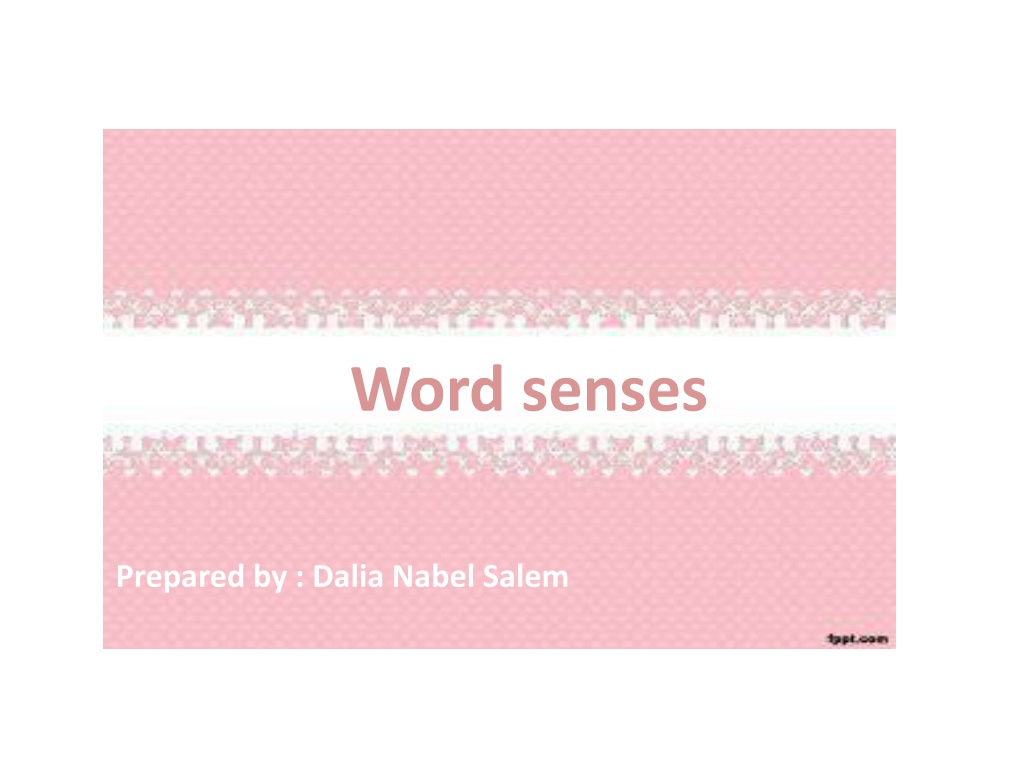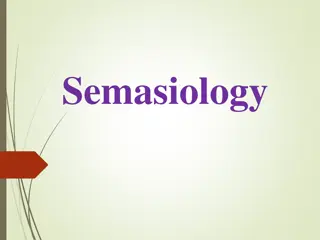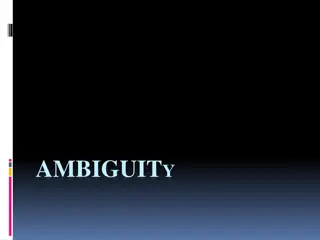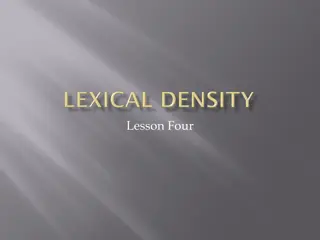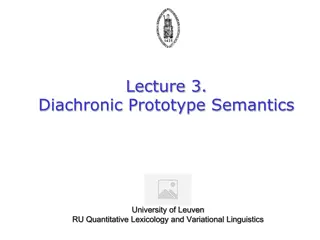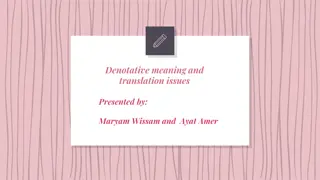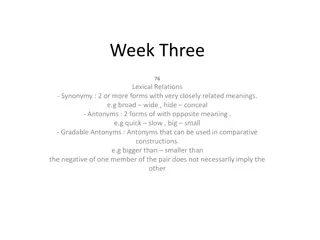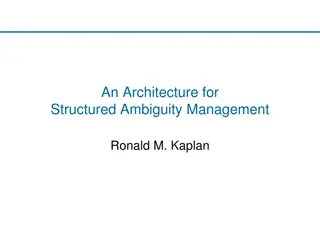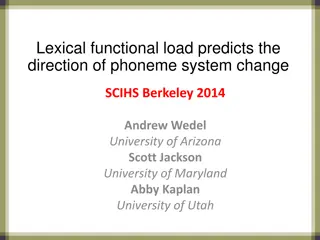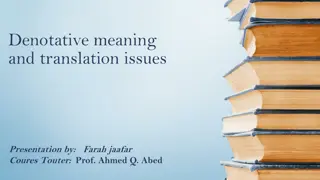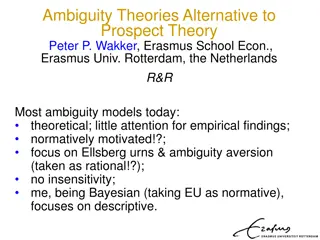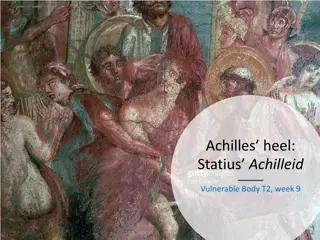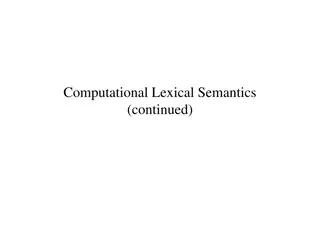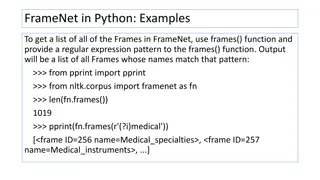Understanding Polysemy and Homonymy in Lexical Ambiguity
In lexical ambiguity, polysemy refers to one word having multiple related senses, while homonymy involves different words that sound the same but have unrelated meanings. Distinguishing between polysemy and homonymy can be challenging, but certain guidelines can help differentiate them based on shared features or components of meaning, figurative extensions, primary senses, and etymology. Understanding these distinctions is crucial to unraveling the organization of information in a speaker's mental vocabulary.
Download Presentation

Please find below an Image/Link to download the presentation.
The content on the website is provided AS IS for your information and personal use only. It may not be sold, licensed, or shared on other websites without obtaining consent from the author. Download presentation by click this link. If you encounter any issues during the download, it is possible that the publisher has removed the file from their server.
E N D
Presentation Transcript
Word senses Prepared by : Dalia Nabel Salem
5.3.3 Polysemy vs. homonymy In lexical ambiguity there are traditionally two types : Polysemy: one word with multiple senses . Homonymy : different words that happen to sound the same.
Both these types involve an ambiguous word form , in how the information is organized in the speaker s mental vocabulary . To make distinction between them , in polysemy the two senses are felt to be (related) in some way there is an intelligible connection of some sort between the two senses . while homonymy , the two senses are (unrelated) which the semantic relationship between the two senses is similar between any two words selected at random . However, it s hard to differentiate between them , some authors reject the distinction entirely . the distinction become useful if the word belong to one .
There are some properties that are prototypical of polysemy vs. Homonymy . Some general guidelines for distinguishing polysemy vs. Homonymy : a. The two senses of polysemous word are generally share at least one notable feature or component of meaning , whereas this is not in general true for homonyms. For example, the sense of foot that denotes a unit of length (12 inches) and shares with the body-part sense the same (approximate size). Also the sense of foot may means base (as in foot of a tree/mountain) shares with the body- part sense the same position or location . In contrast of homonymous , the two senses of row (pull the oars vs. things arranged in a line) which show unrelated meaning in common .
b. If one sense has a figurative extension , the word is probably polysemous . For example, the sense of run in This road runs from Rangoon to Mandalay is arguably based on a metonymy between the act of running and the path traversed by the runner, suggesting that this is a case of polysemy. For homonymous words, neither sense is likely to be (primary) . c. Beekman & Callow (1974) suggest that, for polysemous words, one sense can often be identified as the (primary) sense, with other senses being classified as secondary or figurative. For homonymous words, neither sense is likely to be (primary).
d. Etymology (historical source) is used as a criterion in most dictionaries .it is not a reliable basis for synchronic linguistic analysis. (Speakers may or may not know where certain words come from historically, and their ideas about such questions are often mistaken)there is often a correlation between etymology and the criteria ,because figurative extension is a common factor in semantic change over time . This point consider a specific application of a more general principle in the study of lexical meaning, because word meanings may change over time, and the historical meaning of a word may be quite different from its modern meaning .
According to Lyons (1977) etymological fallacy is the failure to respect the distinction of the diachronic and the synchronic which belief that the meaning of words can be determined by investigating their origins (historical meaning) . Lyons points out that it would be silly to claim that the real meaning of the word (curious) in Modern English is (careful) even though that was the meaning of the Latin word from which it is derived . A number of authors have distinguished between regularor systematic polysemy vs. non-systematic polysemy. Systematic polysemy involves senses which are related in predictable ways. For example, many verbs which denote a change of state (break, melt, split, etc.(have two senses, one transitive (Vtr) and the other intransitive (Vintr), with Vtr meaning roughly cause to Vintr . Similarly, many nouns that refer to things used as instruments (hammer, saw, paddle, whip, brush, comb) can also be used as verbs meaning .
some authors have suggested that only the base or core meaning of systematic needs to be included in the lexicon, because the secondary senses can be derived by rule. But even in the case of systematic polysemy, secondary needs to be listed because not every extended sense which the rules would actually occur in the language. For example, there are no verbal uses for some instrumental nouns, e.g. (scalpel, yardstick, hatchet, pliers, tweezers, etc.) For others, verbal uses are possible only for non-standard uses of the instrument . In dictionaries all the senses of polysemous word will be listed within a single lexical entry, while homonyms will occur in separate lexical entries .
5.3.4 One sense at a time When an ambiguous word uttered by the speaker , the listener expects one indented meaning depending on the context Cruse (1986) cites a sentence in which contains five lexically ambiguous words Several rare ferns grow on the steep banks of the burn where it runs into the lake. Crusewrites In such cases, there will occur a kind of mutual negotiation between the various options [so as to determine which sense for each word produces a coherent meaning for the sentence as a whole].
The context of the utterance usually one sense, which is intended . When an interpreter tells us his author could be using such-and such a word with sense a, or he could be using it with sense b, and then sits on the fence claiming perhaps the author means both, it should avoid the suspicion that the interpreter is simply manipulates in the explanation. Sometimes, of course, the speaker does intend both senses to be available to the hearer but this is normally intended as some kind of play on words . 5.3.5 Disambiguation in context Word meanings are clarified or restricted by their context of use in several different ways
Disambiguation can achieves by determine the feature of context, linguistic or pragmatic context For example, the nurse who checked my blood pressure was pregnant. The word (nurse) alone can't understand if he/ she , only when add a specific feature (pregnant) it becomes clear that refer to female In disambiguation the recognition knowledge about the world plays an important role in making this disambiguation possible
in Polysemy is rarely considers a problem for communication among people. people so clever at using contextual signals that they select the appropriate senses of words effortlessly and unconsciously , except as a source of humor and puns . lexical ambiguity is not (usually) a problem for human speakers, it is a significant problem for computers . much of the recent work on polysemy has been carried out within the field of computational linguistics. Because computational work typically deals with written language.
Computation works also focus on Homographs ( words are identical in spelling) more than Homophones (words are identical in pronunciation) , in contrast to traditional linguistics which has been more concerned with spoken language. Because of English spelling inconsistencies, not always coincide the two case . Ravin & Leacock note that lexical ambiguity poses a problem for translation. The problem arises because distinct senses of a given word-form are unlikely to have the same translation equivalent in another language. Lexical ambiguity can cause problems for translation in at least two ways: either the wrong sense may be chosen for a word which is ambiguous in the source language, or the nearest translation equivalent for some word in the source language may be ambiguous in the target language.
For example the type occurred in the English text of a bilingual menu in a Chinese restaurant, which offered (deep-friedenema fried sausage esenihC eman fo eht hsid si ( naht rehtar ( deep- ehT ( . zh gu nchang . in the last two characters of the name refer to a kind of sausage made of wheat flour ; but they also have another sense, namely enema (a standard injection to relieve constipation). The translator (whether human or machine) chose the wrong sense for this context .
A translation equivalent in the target language can create ambiguity in the translated version that is not present in the original . For example, the French word apprivoiser (to tame) plays a major role in the book Le Petit Prince (The Little Prince) . In most Portuguese versions this word is translate dascativar ,which can mean (tame) can also mean (catch, capture, enslave, captivate, enthrall, charm, etc.). This means that the translation is potentially ambiguous in a way that the original is not. It is not surprise that homonymy poses a problem for translation, because homonymy is anaccidental similarity of form; there is no reason to expect the two senses to be associated with a single form in another language. If it happen to find a pair of homonyms in some other language , it will be a good translation equivalents for a pair of English homonyms .
But with polysemy ,where the senses are related in some way , we cannot in general expect that the different senses can be translated using the same word in the target language . Beekman & Callow (1974) state: Whether multiple senses of a word arise from a shared [component] of meaning or from relations which associate the senses [i.e. figurative extensions PK], the cluster of senses symbolized by a single word is always specific to the language under study . Since there is an intelligible relationship between polysemous senses, it is certainly possible for the same relationship to be found in more than one language; but often this turns out not to be the case, which is why polysemy can be a source of problems for translators .
Context-dependent extensions of meaning Cruse (1986; 2000) distinguishes between established vs. non-established senses. an established sense( is the meaning which speaker stored permanently in the mental lexicon, which is always available and normally listed in a dictionary ) while non-established (new sense of word which create by the hearer when the context force he/she to invent a new meaning ) When Mark Twain described a certain person as a good man in the word , his hearers were forced to interpret the word good with something close to the opposite of its normal meaning (puritanical, self-righteous , or judgmental).Clearly this( sense) of the word good is not permanently stored in the hearer s mental lexicon, and it s not expect to see it listed in a dictionary entry for good. It exists only on specific context.
There is a general term for this process of non-establish called (coercion) Coercion provides a mechanism for extending the range of meanings of word. It help the speaker who intends to communicate something intelligible or relevant to current purposes .If none of the established senses of a word allow for a coherent or intelligible sentence meaning , the hearer tries to create an extended meaning for one or more words that makes sense in the current speech context. also (Coerced meanings )are not stored in the lexicon, but are calculated as needed from the established or default meaning of the word plus contextual factors.
5.4.1 Figurative senses There are Some of the best-known figures of speech (tropes) listed in: Metaphor: a figure of speech in which an implied comparison is made between two unlike things . Hyperbole: a figure of speech in which exaggeration is used for emphasis or effect; an extravagant statement. (e.g., I have eaten more salt than you have eaten rice. _Chinese saying implying seniority in age and wisdom)
Euphemism: a substitution of an in offensive term (such as passed away) for one considered offensively explicit (died). Metonymy: a figure of speech in which one word or phrase is substituted for another with which it is closely associated (such as crown for monarch). Synecdoche: a figure of speech in which a part is used to represent the whole , the whole for a part, the specific for the general and the general for the specific. Litotes: a figure of speech consisting of an understatement in which an affirmative is expressed by negating its opposite (e.g. not bad to mean good ).
Irony: a figure of speech in which the intended meaning of the expression is the opposite of its literal meaning. these figures of speech consider as patterns of reasoning that will allow a hearer to provide an extended sense when all available established senses fail to produce an acceptable interpretation of the speaker s utterance . 5.4.2 How figurative senses become established figurative senses are not stored in the speaker/hearer s mental lexicon . It used when the context required to use
some of figurative sense (popular one) after frequent repetition they lose their sense of freshness or novelty associated with their original use , this expression called (clich s) . Using figurative senses frequently may become lexicalized, and begin to function as established senses. For example, the original sense of (grasp) is ( to hold in the hand) ,but a new sense has developed from a metaphorical use of the word to mean (understand). Similar examples include (freeze) (ice) becomes (remain motionless) When the hearer faces a meaning based on specific contextual or cultural factors ,the intended meaning is simply selected from among the established senses already available .
When established senses develop out of metaphors it will referred to as conventional metaphors , in contrast to (novel or creative) metaphors which are newly created . Conventional metaphors are sometimes referred to as dead or frozen metaphors, can defines as (phrases which are expressing the intuition that the meaning of such expressions is static rather than dynamic). in some cases the original literal sense of a word may fall out of use, leaving what was originally a figurative sense as the only sense of that word . For example , the noun fathom refers to a unit of length , the verb to fathomoriginally referred to measuring the depth of something, usually of some body of water. In current usage the verb is only used in its metaphorical sense, (tounderstand) also for noun owl which originally referred to a type of bird. now list only the conventional metaphor sense, as ( a person who habitually stays out late at night ) .
Translation equivalents in different languages are unlikely to share the same range of polysemous senses. For example ,the closest translation equivalent for grasp in Malay is p gang ; but this verb never carries the sense of (understand). metaphors can sometimes survive and be explained when translated into a different language, because the general patterns of meaning extension are not universal, used at least across a wide range of languages . Conventional metaphors are much less likely to work in translation, because the specific contextual features which motivated the creative use of the metaphor need no longer be present
5.5 Facets of meaning There are different uses are often cited as cases of systematic polysemy , such distinct senses related by a productive rule of some kind. Cruse (2000; 2004) argues that they are best analyzed of (facets) of a single sense. For example the word bank (Cruse 2000 ) a. The bank in the High Street was blown up last night. [premises] b. That used to be the friendliest bank in town. [personnel] c. This bank was founded in 1575. [institution]
systematic polysemy analysis are unlike normal polysemous senses(non-antagonistic and don t give rise to zeugma effects), which are antagonistic. Under the systematic polysemy analysis it might derive the senses by a kind of metonymy . figurative senses are antagonistic with their literal counterparts. This suggests that facets are not figurative senses. (23) My religion forbids me to eat or wear rabbit. (24) . I m parked out back. c. Yeats is widely read although he has been dead for over 50 years. d. Yeats is widely read, even though most of it is now out of print. (25) The White House needs a coat of paint but refuses to ask Congress for the money. Zeugma is a figure of speech in which a single word joins two (or more) parts of a sentence, often used to create a literary effect
